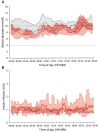Severe Hypoglycemia: Is It Still a Threat for Children and Adolescents With Type 1 Diabetes?
- PMID: 33042005
- PMCID: PMC7523511
- DOI: 10.3389/fendo.2020.00609
Severe Hypoglycemia: Is It Still a Threat for Children and Adolescents With Type 1 Diabetes?
Abstract
Severe hypoglycemia is defined as a condition with serious cognitive dysfunction, such as a convulsion and coma, requiring external help from other persons. This condition is still lethal and is reported to be the cause of death in 4-10% in children and adolescents with type 1 diabetes. The incidence of severe hypoglycemia in the pediatric population was previously reported as high as more than 50-100 patient-years; however, there was a decline in the frequency of severe hypoglycemia during the past decades, and relationship with glycemic control became weaker than previously reported. A lot of studies have shown the neurological sequelae with severe hypoglycemia as cognitive dysfunction and abnormalities in brain structure. This serious condition also provides negative psychosocial outcomes and undesirable compensatory behaviors. Various possible factors, such as younger age, recurrent hypoglycemia, nocturnal hypoglycemia, and impaired awareness of hypoglycemia, are possible risk factors for developing severe hypoglycemia. A low HbA1c level is not a predictable value for severe hypoglycemia. Prevention of severe hypoglycemia remains one of the most critical issues in the management of pediatric patients with type 1 diabetes. Advanced technologies, such as continuous glucose monitoring (CGM), intermittently scanned CGM, and sensor-augmented pump therapy with low-glucose suspend system, potentially minimize the occurrence of severe hypoglycemia without worsening overall glycemic control. Hybrid closed-loop system must be the most promising tool for achieving optimal glycemic control with preventing the occurrence of severe hypoglycemia in pediatric patients with type 1 diabetes.
Keywords: advanced technology; children and adolescents; risk factor; severe hypoglycemia; type 1 diabetes.
Copyright © 2020 Urakami.
Figures



Similar articles
-
The Advanced Diabetes Technologies for Reduction of the Frequency of Hypoglycemia and Minimizing the Occurrence of Severe Hypoglycemia in Children and Adolescents with Type 1 Diabetes.J Clin Med. 2023 Jan 18;12(3):781. doi: 10.3390/jcm12030781. J Clin Med. 2023. PMID: 36769430 Free PMC article. Review.
-
Prevalence and predictors of severe hypoglycemia in Danish children and adolescents with diabetes.Pediatr Diabetes. 2015 Aug;16(5):354-60. doi: 10.1111/pedi.12171. Epub 2014 Jul 12. Pediatr Diabetes. 2015. PMID: 25039921
-
Impaired awareness of hypoglycemia in children and adolescents with type 1 diabetes mellitus in north of Jordan.BMC Endocr Disord. 2019 Oct 24;19(1):107. doi: 10.1186/s12902-019-0441-9. BMC Endocr Disord. 2019. PMID: 31651281 Free PMC article.
-
Continuous Glucose Monitoring: A Review of Recent Studies Demonstrating Improved Glycemic Outcomes.Diabetes Technol Ther. 2017 Jun;19(S3):S25-S37. doi: 10.1089/dia.2017.0035. Diabetes Technol Ther. 2017. PMID: 28585879 Free PMC article. Review.
-
Diabetes technology and treatments in the paediatric age group.Int J Clin Pract Suppl. 2011 Feb;(170):76-82. doi: 10.1111/j.1742-1241.2010.02582.x. Int J Clin Pract Suppl. 2011. PMID: 21323816 Review.
Cited by
-
New Fast Acting Glucagon for Recovery from Hypoglycemia, a Life-Threatening Situation: Nasal Powder and Injected Stable Solutions.Int J Mol Sci. 2021 Sep 30;22(19):10643. doi: 10.3390/ijms221910643. Int J Mol Sci. 2021. PMID: 34638984 Free PMC article. Review.
-
Characterising common challenges faced by parental caregivers of children with type 1 diabetes mellitus in mainland China: a qualitative study.BMJ Open. 2022 Jan 11;12(1):e048763. doi: 10.1136/bmjopen-2021-048763. BMJ Open. 2022. PMID: 35017233 Free PMC article.
-
Recommendations for recognizing, risk stratifying, treating, and managing children and adolescents with hypoglycemia.Front Endocrinol (Lausanne). 2024 Jun 4;15:1387537. doi: 10.3389/fendo.2024.1387537. eCollection 2024. Front Endocrinol (Lausanne). 2024. PMID: 38894740 Free PMC article.
-
Cognitive flexibility is associated with the age of onset and duration among patients with type 1 diabetes.Sci Rep. 2025 Jul 7;15(1):24222. doi: 10.1038/s41598-025-99678-2. Sci Rep. 2025. PMID: 40624300 Free PMC article.
-
A Multicenter Prospective Evaluation of the Benefits of Two Advanced Hybrid Closed-Loop Systems in Glucose Control and Patient-Reported Outcomes in a Real-world Setting.Diabetes Care. 2024 Feb 1;47(2):216-224. doi: 10.2337/dc23-1355. Diabetes Care. 2024. PMID: 37948469 Free PMC article.
References
Publication types
MeSH terms
Substances
LinkOut - more resources
Full Text Sources
Medical
Miscellaneous

